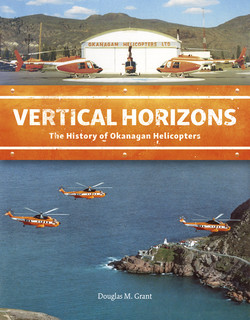Читать книгу Vertical Horizons - Douglas M. Grant - Страница 6
На сайте Литреса книга снята с продажи.
ОглавлениеIntroduction
I was employed by Okanagan Helicopters from the mid-1970s until the mid-1980s, but it wasn’t until 2006, when I was working on an aircraft restoration project in Vancouver, that a friend, after listening to one of my stories, asked if a history of the company had ever been written. I was certain that someone had already done it but was surprised to discover the only information on the company was in Helicopters: The British Columbia Story and Helicopters in the High Country by Peter Corley-Smith and David N. Parker. While excellent, these books only cover the company’s early days and touch briefly on the Kemano project of the 1950s. I realized how much more there was to be told and that, if nothing was written down, an important part of Canadian aviation history would disappear.
Okanagan Helicopters went from humble beginnings in August 1947, when Carl Agar and Alf Stringer landed their first machine, a new Bell 47B-3, in Penticton, BC, to become the third-largest helicopter company in the world 40 years later, with 600 employees and over 125 machines in 33 countries. During my research I came to understand the extent of their accomplishments. In the early years Carl had faced the challenge of flying high-mountain terrain and started the first training school in Penticton to teach others how to do it. As the company grew, it began providing support to geological and topographic surveys, the forest, fisheries and mining industries, hydroelectric construction projects, petroleum exploration and operations as well as firefighting, heli-skiing, air ambulance and taxi services. The company’s helicopters seeded large areas of forest, trained military and civilian pilots in mountain flying, carried out polar bear counts in the High Arctic in all weather conditions and supported hydro tower installation. Two of their more dramatic operations involved relocating a 2,750-pound (1,250-kilogram) orca from a swimming pool to an aquarium and installing a rod to measure wind speed and air temperature on the top of the CN Tower in Toronto. The introduction of instrument flight rules (IFR) made it possible for Okanagan’s helicopters to fly to oil rigs 150 miles (240 kilometres) offshore and operate in the High Arctic in winter; one of their biggest challenges was flying IFR with under-slung loads in those long, dark Arctic days.
In 1965 they flew the first unescorted commercial helicopter ferry flight from the USA to the UK. A few years later an Okanagan S-61, again unescorted, flew from Sydney, Nova Scotia, to Songkhla, Thailand, a distance of 12,659 miles (20,322 kilometres). Some of the countries that saw the bright orange helicopters with Okanagan’s hummingbird logo were Pakistan, India, Zaire, Egypt, Ireland, Thailand, the Philippines, Singapore, Myanmar, Cambodia, China, Australia, New Zealand, Papua New Guinea, the USA, Puerto Rico, Nicaragua, Guyana, Haiti, Suriname, Peru, Venezuela and Greenland.
On the engineering side, in the early days Alf Stringer always found ways to keep the machines flying with a minimum of support when even the Department of Transport knew little about helicopter maintenance or operation. Often it was the crews in the field who came up with solutions to operational problems, which, once proven successful, were recorded in the company’s safety and operational standards manual and then adopted by other operators. Some of the more impressive engineering feats included the development of a monsoon bucket for forest fire control, a power-line stringer installed on an S-58 and a special bucket for moving salmon to spawning grounds. Other notable innovations included tree clippers for forestry operations, spraying equipment and drip torches, and Bambi Buckets for firefighting.
This book is an attempt to provide a record of Okanagan Helicopters’ entire 40 years of operation, the developments the company pioneered and the stories of the crews that made its success possible.
Douglas M. Grant,
West Kelowna, BC
